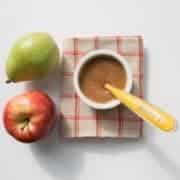Making Your Own Baby Food
Do you know what the most popular conversation topic is for French parents? Food, of course! Food is a major staple of French cultural heritage, and we are more interested in talking about what our baby will be eating for lunch than how he slept last night! We love sharing tips to train the palate of our little ones.
If you are a new mom, I bet you already talk with your mom, girlfriends or pediatrician about your baby’s transition to solid foods. One of the first questions you might have is whether to make your own baby food or buy store-bought baby food. Whether you think it is too difficult or time-consuming to make your own baby food, you should definitely give it a try! With good tools on hand, you could find it easy, fun, and rewarding.
I think the biggest advantage of making your own baby food is knowing exactly what goes into your baby’s mouth and choosing the best ingredients. By selecting seasonal fresh fruits, vegetables, and other produce from local grocers, your meals will be tastier and more nutritious than any commercial jars. Most of the vitamins and nutrients are gone when jarred foods are processed at hot temperatures that allow them to be shelf-stable. If you make your own food, your baby can discover some tastes that you will rarely find in the baby food aisle– you can experiment with fennel, eggplant, fish, and much more. In fact, recent studies show that babies who eat homemade food not only have a lower body fat mass between the ages of 1 and 3, but they also have a more diverse diet than those who eat commercially processed baby food. And of course, your food will be free of the preservatives and additives that we still find in a lot of industrially prepared infant food.
Another big advantage to making baby food is tailoring the meals to your baby’s development. As your baby grows, he needs to be introduced to more challenging textures that will train him to chew. You can blend, mash, puree coarsely, chop or add texture with couscous, quinoa, or little pasta. By doing so, you will be able to offer more options than what the industrial baby food has to offer and help him transition to table food.
When starting to feed my son’s solid food, one of the most important things for me has always been educating their taste while making sure their meals were balanced. In the baby aisle today, the majority of blends have a sweet taste by blending fruits and vegetables together. Those products are definitely more palatable for babies but don’t train them to like veggies! Babies have a blank palate, and we underestimate their ability to like vegetables. I always made sure my sons were having their side of fresh veggies at every meal and their portion of fruit at the end of the meal. I’m happy to say that for the most part, they learned to eat and like their veggies.
In her book First Bite, Bee Wilson says,”A parent feeding a baby is training him or her how food should taste.” Nourishing your child goes beyond providing nutrients for his growing body, it is also transmitting an intangible heritage and helping them get healthy eating habits for a lifetime. Cooking for your baby using fresh, wholesome produce is an experience that will awaken all the senses of your little one, so take that opportunity to show them different flavors.
References
http://www.nature.com/ijo/journal/vaop/ncurrent/abs/ijo201737a.html













Leave a Reply
Want to join the discussion?Feel free to contribute!